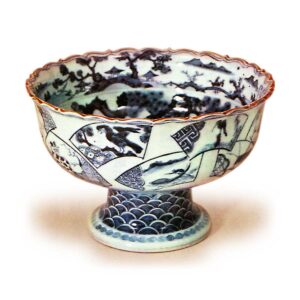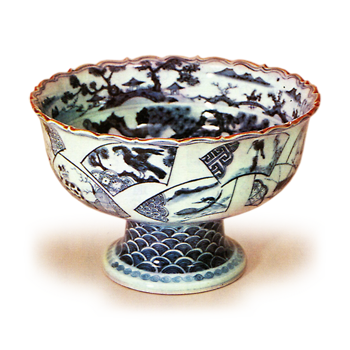
Konan-yaki is a pottery produced in Otsu, Omi Province (Shiga Prefecture). In 1850 (Kaei 3), Eiraku Shoji moved east with a plan to open a kiln in Edo (Tokyo), but his plan was different from his original plan. The name “Otsu” comes from the fact that Otsu lies to the south of Lake Biwa. In 1852 (5th year of the same year), he moved to Shikanoseki-cho, Mitsui Temple, and opened his own house. He brought in former customers from Kyoto, including Wakakusa Jisuke and Hari Chujiro, and sold his products widely in Kyoto, Osaka, and other regions. His works were mainly tea utensils, sake cups, plates, bowls, flower vases, incense burners, and ornaments, and were of the following types: underglaze blue, gosu-red, gold brocade, soba-no-te, and yakishime.
Of these, some of the best examples are in the Shozui-shoji and kozu-tsuke styles. His paintings were especially skillful, depicting animals and insects as if they were alive. The quality of his ceramics is a little under-fired compared to the Gojozaka kiln in Kyoto, but in fact, there is a kind of oddity to them. The most common inscriptions on Hunan wares are “In Hunan Yongle Zou” in two lines of six characters, “Yongle Preservation Made in Hunan” in two lines of eight characters, “Dai Nihon Hunan Yongle Preservation Zou” in two lines across, “Hunan Yongle Zou,” and “Touchen,” which was given by Akayama Mokuho in the past. In addition, there is an inscription “陶世鳴” given by Prince Chihito Arisugawa in the fall of 1850, which is used for products other than those for sale, and is not found anywhere else except on Hunan wares. The above inscriptions are stamped with a three-character unlined seal for “Changtoushan” in running script and a two-character two-line seal with a four-character square outline for “Mitsui Gohin” in standard script, or with two seals for “Changtoushan” and “Mitsui Gohin” together. The two-character seal with a long rectangular outline in clerical script “Chodo” belongs to the rarest group, and the two-character seal with “Kahama” is unclear as to whether it was made at Shinborihama or Konan Kilns. The two-character “Eiraku” circle mark, three large and three small, and the four-character “Hebin tributary” circle mark in clerical script are also used in Honan ware, especially on pieces such as gosu-red glazed ware, soba-te wares, and stoneware, where it is difficult to use inscriptions in dyed slip, while the “Hebin tributary” seal is only rarely seen. The name of the item is written on the back of the box, the reverse side is marked “Made for Hunan Conservation,” and a two-character “Eiraku” seal is usually used on the right shoulder of the box. Sometimes, the year is added, such as Shin Hai Chuju (the middle of autumn in the year 1911). The string is called “Eiraku string.” Paulownia wood is also used for the box, but for some reason, most Konan ware is made of Satsuma wood or masaasa.



